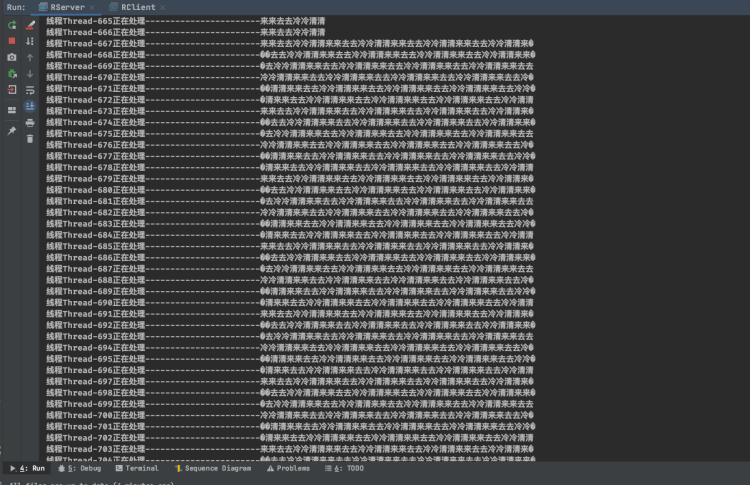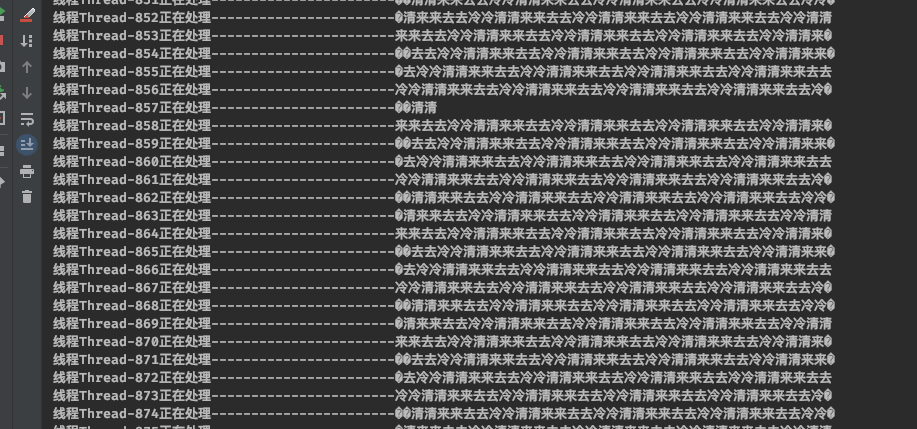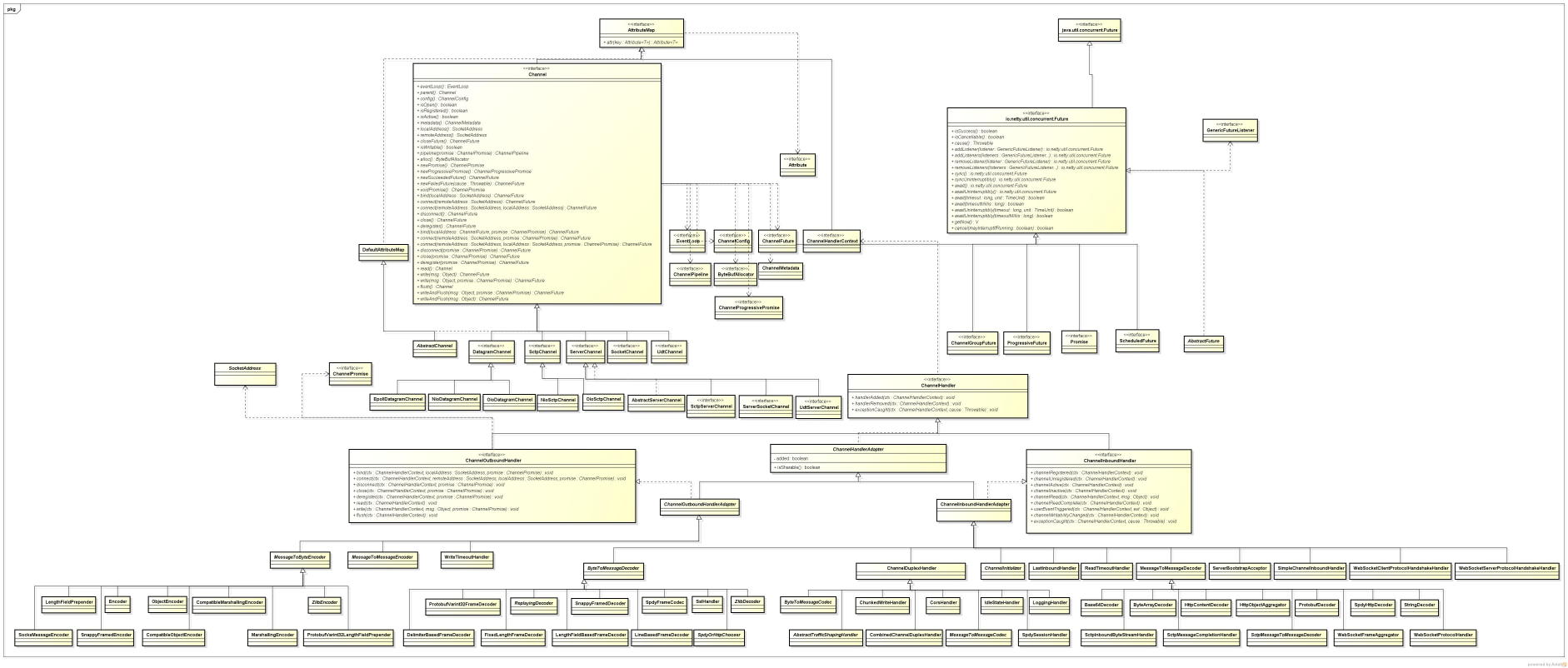IO和NIO
在以前,我们要进行不同机器上的网络通信,使用的是OIO,也就是ServerSocket和Socket那一套。 这套技术,会造成服务端每建立一个连接就需要开启一个线程处理,造成的后果就是线程资源浪费。对服务端来说,造成oom、cpu拉满等问题都是可能的。
package cn.europa;
import java.io.IOException;
import java.io.InputStream;
import java.io.OutputStream;
import java.net.ServerSocket;
import java.net.Socket;
public class Server {
public static void main(String[] args) {
Server server = new Server();
server.start();
}
private void start() {
try {
ServerSocket serverSocket = new ServerSocket(9890);
while (true) {
Socket socket = serverSocket.accept();
Thread thread = new Thread(new Task(socket));
thread.start();
}
} catch (IOException e) {
e.printStackTrace();
}
}
private class Task implements Runnable {
private final Socket socket;
public Task(Socket socket) {
this.socket = socket;
}
@Override
public void run() {
try {
while (!Thread.interrupted()) {
InputStream inputStream = socket.getInputStream();
byte[] buffer = new byte[100];
int length = 100;
StringBuilder stb = new StringBuilder();
while (length == 100) {
length = inputStream.read(buffer);
stb.append(new String(buffer, 0, length));
}
System.out.println(Thread.currentThread().getName() + "线程读取--------------------------:\n" + stb.toString());
OutputStream outputStream = socket.getOutputStream();
outputStream.write("你好".getBytes());
}
} catch (IOException e) {
e.printStackTrace();
}
}
}
}
package cn.europa;
import java.io.IOException;
import java.io.OutputStream;
import java.net.InetSocketAddress;
import java.net.Socket;
import java.util.Scanner;
public class Client {
public static void main(String[] args) {
try {
Socket socket = new Socket("127.0.0.1", 9890);
while (!Thread.interrupted()) {
OutputStream outputStream = socket.getOutputStream();
Scanner scanner = new Scanner(System.in);
System.out.println("请输入>>");
while (scanner.hasNext()) {
System.out.println("请输入>>");
String next = scanner.next();
outputStream.write(next.getBytes());
}
}
} catch (IOException e) {
e.printStackTrace();
}
}
}
NIO的演进
在这里需要提前了解一个概念, Java里的nio并非单独是linux上的nio,其实他也支持multiplexing io模型,也就是多路复用。
1. 非阻塞式的IO模型
linux里的非阻塞io模型,其实指的是在read、write这两大操作系统指令的时候,会非阻塞。比如如果没有数据进行操作,会直接返回空等。但是在Java nio中,也能看到类似的形式,但其实概念上是不一样的。Java nio在accept的时候,服务端可以一直循环并在没有accept到连接的时候处理其他事情。
package cn.europa.nio;
import java.io.IOException;
import java.net.InetSocketAddress;
import java.nio.ByteBuffer;
import java.nio.channels.ServerSocketChannel;
import java.nio.channels.SocketChannel;
public class NioServer {
public static void main(String[] args) {
try {
ServerSocketChannel server = ServerSocketChannel.open();
server.configureBlocking(false);
server.bind(new InetSocketAddress(9999));
while (true) {
SocketChannel socketChannel = server.accept();
if (socketChannel == null) {
System.out.println("----无建立连接,主线程干别的事情");
try {
Thread.sleep(2000);
} catch (InterruptedException e) {
e.printStackTrace();
}
continue;
}
new Thread(new Task(socketChannel)).start();
}
} catch (IOException e) {
e.printStackTrace();
}
}
private static class Task implements Runnable {
private SocketChannel socketChannel;
public Task(SocketChannel socketChannel) throws IOException {
this.socketChannel = socketChannel;
// 将此channel设置为非阻塞的。
// socketChannel.configureBlocking(false);
}
@Override
public void run() {
while (!Thread.interrupted()) {
ByteBuffer buffer = ByteBuffer.allocate(1024);
try {
int length = 0;
StringBuilder stb = new StringBuilder();
while (length == 0) {
System.out.println(Thread.currentThread().getName() + "正在读取读取。");
length = socketChannel.read(buffer);
stb.append(new String(buffer.array()).trim());
}
System.out.println("线程" + Thread.currentThread().getName() + "读取数据-----------------------------" + stb.toString());
} catch (IOException e) {
e.printStackTrace();
}
}
if (socketChannel != null) {
try {
socketChannel.close();
} catch (IOException e) {
e.printStackTrace();
}
}
}
}
}
package cn.europa.nio;
import java.io.IOException;
import java.io.OutputStream;
import java.net.InetSocketAddress;
import java.net.Socket;
import java.nio.ByteBuffer;
import java.nio.channels.SocketChannel;
import java.util.Scanner;
public class NioClient {
public static void main(String[] args) {
try {
SocketChannel channel = SocketChannel.open(new InetSocketAddress("127.0.0.1", 9999));
channel.configureBlocking(false);
while (!Thread.interrupted()) {
Scanner scanner = new Scanner(System.in);
System.out.println("请输入>>");
while (scanner.hasNext()) {
System.out.println("请输入>>");
String next = scanner.next();
channel.write(ByteBuffer.wrap(next.getBytes()));
}
}
} catch (IOException e) {
e.printStackTrace();
}
}
}
2. NIO的三大组件
2.1 Selector
出了上述之外,多路复用还有其他的强大点,这里需要了解到多路复用这个知识。也就是Linux里的select(早期)、epoll。mac os里的kqueue。在不同的操作系统里叫法不一样而已。他其实是一个内部不断循环的函数,将注册到selector上的事件循环到,并让你能够获取到当前事件。
package cn.europa.reactor;
import java.io.IOException;
import java.net.InetSocketAddress;
import java.nio.ByteBuffer;
import java.nio.channels.SelectionKey;
import java.nio.channels.Selector;
import java.nio.channels.ServerSocketChannel;
import java.nio.channels.SocketChannel;
import java.util.Iterator;
import java.util.Set;
public class RServer {
private static Selector selector;
private static ServerSocketChannel serverChannel;
public static void main(String[] args) {
try {
selector = Selector.open();
serverChannel = ServerSocketChannel.open();
serverChannel.configureBlocking(false);
serverChannel.bind(new InetSocketAddress(9099));
serverChannel.register(selector, SelectionKey.OP_ACCEPT);
while (!Thread.interrupted()) {
selector.select();
Set<SelectionKey> keys = selector.selectedKeys();
Iterator<SelectionKey> keyIt = keys.iterator();
while (keyIt.hasNext()) {
SelectionKey key = keyIt.next();
if (key.isAcceptable()) {
ServerSocketChannel serverSocketChannel = (ServerSocketChannel) key.channel();
SocketChannel channel = serverSocketChannel.accept();
// 1、注册新io事件时一定要判断是否是null并且在null时重试。不然不会注册新事件。
if (channel == null) {
continue;
}
channel.configureBlocking(false);
channel.register(selector, SelectionKey.OP_READ);
}
if (key.isReadable()) {
new Thread(new IOHandler(key)).start();
}
// 2、需要remove掉这个key,nio中这个是累加的,不然下次会再次处理上一个io事件。
keyIt.remove();
}
}
} catch (
IOException e) {
e.printStackTrace();
}
}
private static class IOHandler implements Runnable {
private SelectionKey key;
public IOHandler(SelectionKey key) {
this.key = key;
}
@Override
public void run() {
SocketChannel channel = (SocketChannel) key.channel();
ByteBuffer buffer = ByteBuffer.allocate(100);
int length = 0;
StringBuilder stb = new StringBuilder();
while (length == 0) {
try {
length = channel.read(buffer);
stb.append(new String(buffer.array()).trim());
} catch (IOException e) {
e.printStackTrace();
}
}
System.out.println("线程" + Thread.currentThread().getName() + "正在处理-----------------------" + stb.toString());
}
}
}
2.2 Buffer
不同于OIO中基于stream进行数据操作,NIO中会用缓冲区进行数据交换,服务端和客户端会基于这个缓冲区进行数据读取和写入。当然它可能比想象的复杂,包括需要了解翻转等概念。
2.3 Channel
关于channel,在nio中,不同于socket、一个连接就是一个通道,在底层就是操作系统上的文件描述符的操作,对于连接,在服务器端会有监听连接的文件描述符,监听成千上万的客户端连接。对于传输数据,客户端和服务端都有一个传输文件描述符,建立起专项通道进行数据的传输。
3. NIO的问题
NIO饱受诟病的几点
- 在你io事件在处理的时候,可能select又循环到了这个io事件,然后又处理了一次。
- 编程较复杂,在上述服务端代码的注视处均需注意,不然可能就踩坑了。
- 沾包、半包的问题。说起来可能比较难理解,看下客户端代码和运行结果。我们的想法是客户端没输入一次,就进行一次数据传输write。
package cn.europa.reactor;
import java.io.IOException;
import java.net.InetSocketAddress;
import java.nio.ByteBuffer;
import java.nio.channels.SocketChannel;
import java.util.Scanner;
public class RClient {
public static void main(String[] args) {
try {
SocketChannel channel = SocketChannel.open(new InetSocketAddress("127.0.0.1", 9099));
channel.configureBlocking(false);
while (!Thread.interrupted()) {
Scanner scanner = new Scanner(System.in);
System.out.println("请输入>>");
while (scanner.hasNext()) {
System.out.println("请输入>>");
String next = scanner.next();
ByteBuffer buffer = ByteBuffer.allocate(100);
for (int i = 0; i < 1000; i++) {
buffer.put(next.getBytes());
// 涉及到了buffer的翻转
buffer.flip();
channel.write(buffer);
buffer.clear();
}
}
}
} catch (IOException e) {
e.printStackTrace();
}
}
}



为了更明显,我选择了重复的词语。 可以看到,明明只发了几个字,结果每次读取。要么读了好几次(沾包),要么读到了个破碎的包(半包)。 这是因为nio是基于缓冲区的,客户端只负责往里写。而每次服务端来捞取固定长度字节的时候,可能客户端已经写了好多字节了,也可能还没写到100个字节。
Netty
netty的组件比较多
- channel
- pipeline
- bootstrap
- bytebuf
- handler
等等..

关于netty